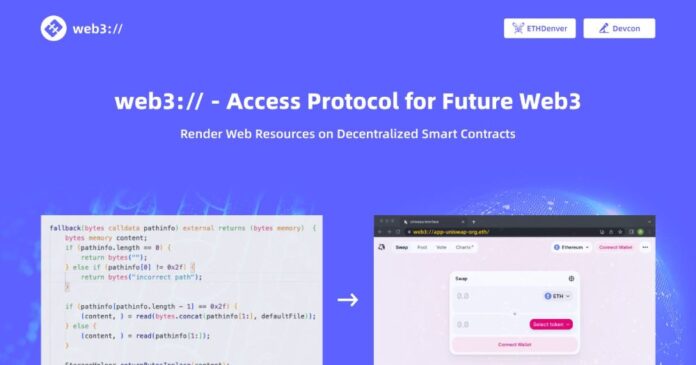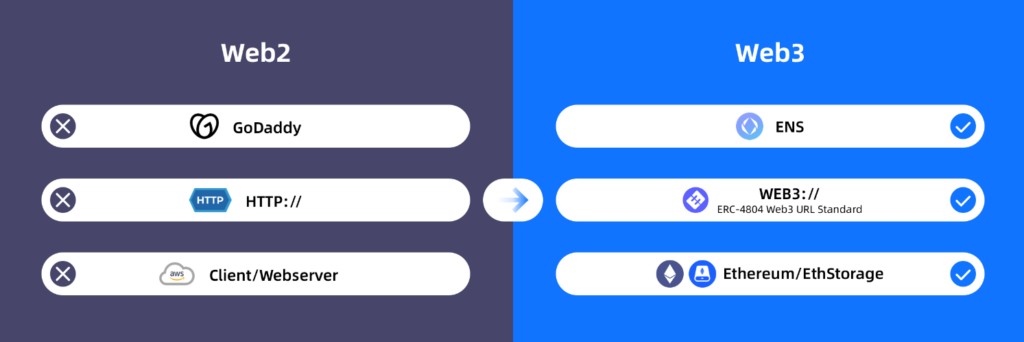
So-called Web3 URLs, which were enabled with the launch of ERC-4804, have made it onto Ethereum — allowing internet users to access Ethereum applications and nonfungible tokens (NFTs) without worrying about centralized censorship.
The new Ethereum standard, titled “Web3 URL to EVM Call Message Translation,” was first proposed on February 14, 2022, and was co-authored by ETHStorage founder Qi Zhou, Ethereum researcher Sam Wilson, and Chao Pi.
It is described as an “HTTP-style” URL to directly access on-chain Web3 content, such as decentralized applications (DApps) front-ends and NFTs. More than a year later, ERC-4804 was approved and finalized on the mainnet on March 1.
According to Anthurine Xiang from layer-2 storage protocol ETHStorage, in many cases – the ecosystem still relies on centralized web servers to access “decentralized” apps.
“Right now, all the DApps like Uniswap […] claim to be decentralized apps,” Xiang explained, adding: “But how [do] we get on the webpage? You have to go through the DNS. You have to go through GoDaddy. […] All those are centralized servers.”
When an internet user clicks a link or types in a website address, the computer uses HTTP (Hypertext Transfer Protocol) to ask another computer to retrieve the information, such as a website.

Under ERC-4804, internet users have the option to type in “web3://” (as opposed to “http://”) in their browsers to bring up DApps or on-chain NFTs directly. This is because the standard allows users to directly run a query to the Ethereum Virtual Machine (EVM).
In theory, entire websites can be accessed by these means as long as their content is stored on the Ethereum blockchain or a compatible layer-2 protocol. However, the costs of doing this are still very prohibitive.
“The critical issue here is that the storage cost on Ethereum is super, super expensive on mainnet,” said ETHStorage founder Qi Zhou. “For example, 1 Gigabyte of on-chain data will cost roughly $10 million. […] That is unacceptable for a lot of Web2 applications and even a lot of NFTs,” adding that layer-2 storage solutions could help mitigate some of the costs.
Xiang noted that the new URL standard makes sense only for specific applications. “Not everything needs to go decentralized,” he said. “If you are running a pretty good Web2 business and you don’t have to worry too much about centralized censorship.”
On the other hand, the new standard would be useful for DApps or websites at risk of censorship. “If you’re a DApp and you’ve already been decentralized, why are you still using a centralized website for people to get access to you?” Xiang explained.
The new Ethereum standard is the first of its kind for the blockchain, though it’s not the first solution to decentralized web hosting. Another example comes from the InterPlanetary File System (IPFS), which was created to do through decentralized means what centralized cloud servers currently provide. The problem, however, is that an IPFS URL can only link to static content, which can’t be amended or changed.
In contrast, ERC-4804 will allow for “dynamic data,” like allowing people to leave likes and comments and interact with content on a website. Furthermore, the standard is also expected to be able to interact with other blockchains much easier.
Now, we’re just waiting for some generally useful decentralized apps we could suggest to you, our reader. In the meantime, nothing stops you from testing a few DApps and seeing whether some of them could work for you. This space has been growing like crazy in recent years and chances are there is something you will find interesting and even useful…
